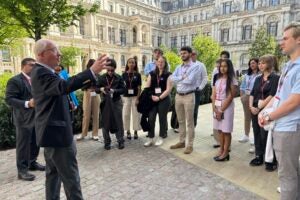AUSTIN, Texas—Researchers from The University of Texas at Austin, Howard Hughes Medical Institute at the Baylor College of Medicine and the National Institutes of Health have created a recombinant human BRCA1 protein and have discovered that the protein binds directly to DNA. Their findings will be published in the May 15 issue of Proceedings of the National Academy of Sciences.
Dr. Tanya Paull, an assistant professor in the department of molecular genetics and microbiology in the UT Austin College of Natural Science, is lead author of the paper.
Scientists have been trying for several years to understand just how the "normal" action of the famous gene prevents development of breast and ovarian cancer and why mutated versions are associated with both breast cancer and ovarian cancer.
BRCA1 plays an important role in protecting cells from cancer, but little is known about how this mechanism works. Paull said her research does not have any immediate application to cancer treatment, but opens up promising new avenues for continued research.
About 50 percent of inherited breast cancer cases are believed to result from BRCA1 mutations and hundreds of mutations in the BRCA1 gene have been found in families where inheritance is believed to be the factor in the higher incidence of cancer.
The scientists said they found that the BRCA1 protein binds strongly and directly to DNA and, as a result, affects the activities of an enzyme believed to be involved in numerous aspects of repairing the breaks in DNA’s double strands. The findings suggest that BRCA1 may play a crucial role in repairing DNA breaks.
"BRCA1 research has branched in many different directions," Paull explained. "Two of the major themes emerging are transcriptional regulation (making an RNA copy of a DNA template) and DNA repair."
Paull said her research shows that "BRCA1 itself can directly bind to DNA, and that it may be one of the initial recognition factors that binds to broken or poorly repaired DNA molecules."
While it has been known that many other proteins bind to BRCA1 and interact with it, the authors hypothesize that BRCA1 may be one of the first repair proteins to recognize DNA damage. They believe that — like the contractor on a construction crew— the gene is responsible for recruiting numerous other molecules to help with the repair job.
Paull said the main question is "what exactly is BRCA1 doing with respect to DNA repair? In addition to binding DNA, it may also be regulating the activities of other protein factors and bridging them together." She added the binding process also "might be central to its role in transcription."
The research was supported by the Helen Hay Whitney Foundation and the National Institutes of Health.
For more information, contact Dr. Tanya Paull at the UT Austin College of Natural Sciences at (512) 232-7802. Contact Dr. David Schneier at (202) 334-2138 at the journal Proceedings of the National Academy of Sciences, for copies of Paull’s paper. For more information about Paull, see the Web site: <www.biosci.utexas.edu/mgm/people/faculty/profiles/paull.htm>. For a photo, see:<www.utexas.edu/admin/opa/news/01newsreleases/nr_200105/cancer2.html>.



